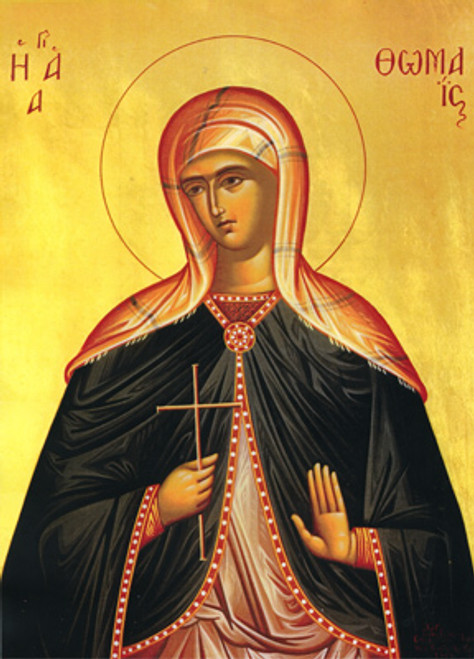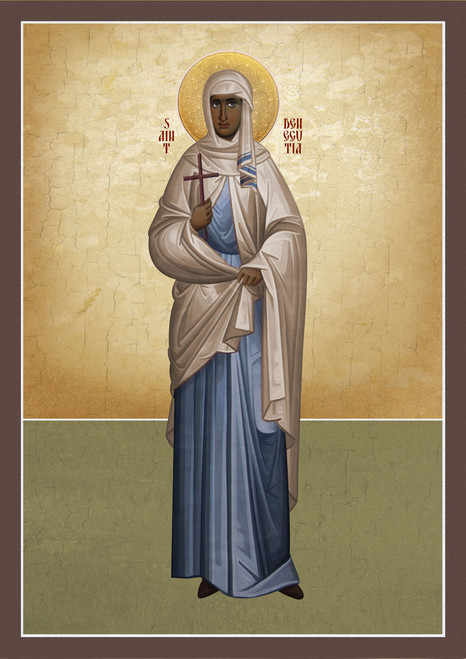Commemorated on March 31
The daughter of Pepin of Landen (580- 646), Mayor of the Palace under the Frankish kings of Austrasia, and St. Itta (also Ida, Itte, or Iduberga; commemorated on May 8/21), St. Gertrude was born in Landen, in present-day Belgium, in 626.
Her mother raised her in piety and nurtured her with love for the life in Christ.
When St. Gertrude was ten years old, her father hosted a banquet, to which King Dagobert I was invited. At this feast, the King asked her if she would like to marry one of his advisors, the son of a Duke.
The girl replied that she desired no other Bridegroom than our Lord Jesus Christ. The guests marveled at her steadfastness of soul and recognized that she was indeed one of God’s elect.
After the death of Pepin , his wife retired to their property in Nivelles Austrasia Map(near present-day Brussels), taking St. Gertrude with her. At the exhortation of St. Amandus, Bishop of Maastricht (†February 6/19), she founded a double monastery for men and women.
Many suitors had wanted to marry the noble young woman so as to gain wealth and power. As we read in the Life of St. Gertrude, to prevent “violent abductors from tearing her daughter away by force,” St. Itta cut her daughter’s hair herself. This tonsure marked her consecration to God.
Having received the monastic veil at the hands of the holy Bishop, St. Gertrude was appointed Abbess by her mother. She was at the time only twenty years old.
Adorned with steadfast faith and rare spiritual discernment, she inspired in the Sisters love for God and zeal for ascetic endeavors.
Her Life states that “in temperance of character, the sobriety of her heart, and the moderation of her words she anticipated maturity.” She was “an intelligent young woman, scholarly and charitable, devoting herself to the sick, elderly, and poor.” She built churches and took care of orphans, widows, captives, and pilgrims. Her spiritual renown spread quickly.
Abbey of Nivelles View of the Collegiate ChurchTwo Irish monks, St. Foillan (†January 16/29) and his brother, St. Ultan (†May 2/15), whom the fearsome King Penda of Mercia had driven out of East Anglia, were welcomed by the Saint at her monastery. They were of great assistance in the organization of worship, and the holy books and Relics which they brought were invaluable treasures for the community.
St Gertrude’s brother, Grimoald I, Mayor of the Palace of Austrasia from 643-656, gave the monks land at Fosses-la-Ville, not far from Nivelles, where they founded a monastery.
The monks remained, however, under the spiritual direction of St. Gertrude, who asked certain of them to teach Holy Scripture to the nuns, and sent others to preach the Gospel in neighboring regions.
One day, as St. Foillan was returning to his monastery after the Divine Liturgy in Nivelles, fursey-brothers-st_ultan_st_foillan_st_furseyhe and his three companions fell into a trap set by bandits in the deep forest. They were slain and their bodies concealed. St. St. Gertrude ordered her monastics to fast and pray that God might reveal the location of St. Foillan’s remains. After seventy-seven days of prayer, she had a vision of a light that illuminated a certain spot in the forest. She sent some people to recover his body, which was reverently borne to his monastery.
St. Foillan’s brother, St. Ultan, thereafter took over the direction of the men’s monastery (655).
After living five years under the direction of her daughter, St. Itta reposed in the Lord (652).
St. Gertrude, desiring to devote herself more completely to prayer, entrusted the external affairs of the monastery to monks and the direction of the monastics to competent nuns.
Dedicated with fervent zeal to fasting, vigil, and prayer, she acquired such boldness before God that, when she was praying in Church, the sisters repeatedly saw a flaming sphere over her head, which illumined the surrounding area by its brightness.
Her great abstinence, however, led to a serious decline in her health, and at the age of thirty, with the consent of her spiritual children, she appointed as Abbess her twenty-year-old niece, St. Wulfetrud, whom she had reared herself.
Living thenceforth as a simple nun, St. Gertrude increased her prayers manyfold, despite her failing strength, and received wondrous revelations from God.
Nivelles (Belgium), fore-part and southern door of the Saint Gertrude Collegiate church (11th or 13th century)Sensing that her end was approaching, she gathered the Sisters, exhorted them to remain faithful to their monastic vows, and instructed them to bury her by covering her body with her hair shirt and her face with an old veil. This hair shirt and veil were later venerated by pilgrims along with her Relics.
She then sent a messenger to St. Ultan at the Monastery of Fosses to ask him what day she would repose.
The Saint informed her that she would give up her soul to God the following day, during the Divine Liturgy, and told her not to fear, since St. Patrick and Holy Angels would be sent by God to receive her soul. Indeed, St. Gertrude gave back her soul to her Heavenly Bridegroom the next day, March 17, 659, after having communed of the Immaculate Mysteries. Immediately after her blessed repose, miracles began to take place at her tomb, and her veneration spread during the Middle Ages throughout all of Northern Europe, where she is honored as the Patron Saint of travelers and
Indeed, St. Gertrude gave back her soul to her Heavenly Bridegroom the next day, March 17/30, 659, after having communed of the Immaculate Mysteries.
Immediately after her blessed repose, miracles began to take place at her tomb, and her veneration spread during the Middle Ages throughout all of Northern Europe, where she is honored as the Patron Saint of travelers and gardeners.







